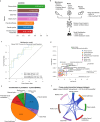Interconnected pathways link faecal microbiota plasma lipids and brain activity to childhood malnutrition related cognition
- PMID: 39773949
- PMCID: PMC11707170
- DOI: 10.1038/s41467-024-55798-3
Interconnected pathways link faecal microbiota plasma lipids and brain activity to childhood malnutrition related cognition
Abstract
Malnutrition affects over 30 million children annually and has profound immediate and enduring repercussions. Survivors often suffer lasting neurocognitive consequences that impact academic performance and socioeconomic outcomes. Mechanistic understanding of the emergence of these consequences is poorly understood. Using multi-system SHAP interpreted random forest models and network analysis, we show that Moderate Acute Malnutrition (MAM) associates with enrichment of faecal Rothia mucilaginosa, Streptococcus salivarius and depletion of Bacteroides fragilis in a cohort of one-year-old children in Dhaka, Bangladesh. These microbiome changes form interconnected pathways that involve reduced plasma odd-chain fatty acid levels, decreased gamma and beta electroencephalogram power in temporal and frontal brain regions, and reduced vocalization. These findings support the hypothesis that prolonged colonization by oral commensal species delay gut microbiome and brain development. While causal links require empirical validation, this study provides insights to improve interventions targeting MAM-associated neurodevelopmental deficits.
© 2025. The Author(s).
Conflict of interest statement
Competing interests: The authors declare no competing interests.
Figures





References
-
- De Onis, M., et al. WHO Global Database on Child Growth and Malnutrition (WHO, 1997).
-
- Martorell, R. & Ho, T. J. Malnutrition, morbidity, and mortality. Popul. Dev. Rev.10, 49–68 (1984).
-
- Jamison, D. T. Child malnutrition and school performance in China. J. Dev. Econ.20, 299–309 (1986).
MeSH terms
Substances
LinkOut - more resources
Full Text Sources
Medical

